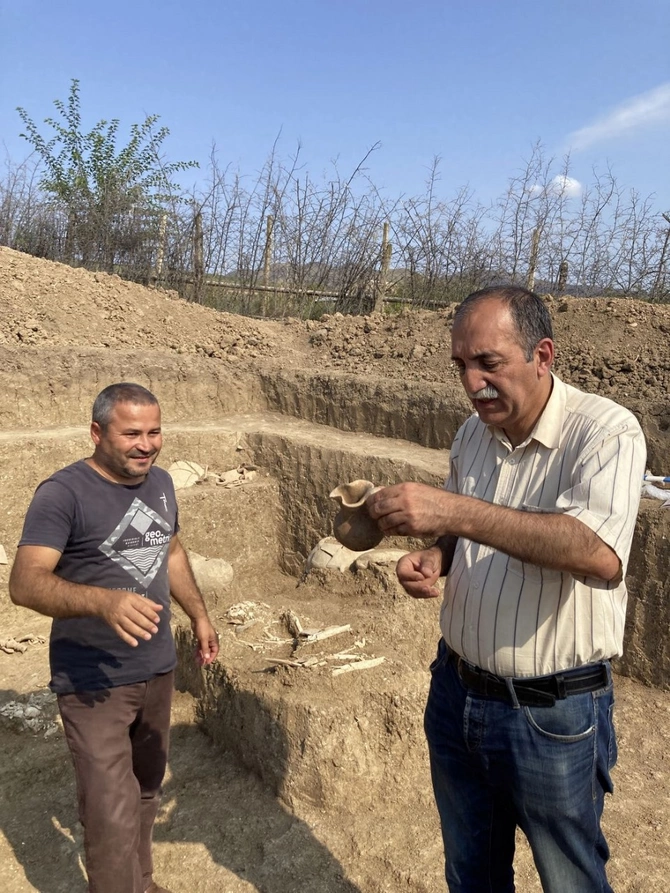
Azerbaijan is an open-air museum with many historical and natural wonders, but some are less well-known than others. Faig Nasibov has been exploring, documenting, and working to protect and preserve these treasures for the last 20 years.
Image: courtesy photo
When Faig Nasibov heard about stone roads that resembled ancient Maltese cart ruts in Azerbaijan’s Absheron peninsula, little did he know that he would uncover a mysterious piece of history.
Faig, a hobby historian and BP project manager, inspected some man-made parallel grooves on the rocky ground while travelling around the area with his colleague.
He met a scholar from Malta and showed him the roads. But the expert came to Faig the next day, after a sleepless night filled with wonder, as to how the exact same kind of cart ruts, directed at the sea and continuing onto the sea bed, existed in Azerbaijan too.
No one knows exactly when or why they were created, but Maltese researchers dated their own stone roads to 4-5,000 BCE. Faig himself has written about Absheron’s cart ruts and other historical locations on his website window2baku.com and believes it is possible that a common civilization may have influenced both the Caspian and Mediterranean roads.
Faig has since become an intrepid explorer, who, together with friends, has been seeking out and documenting Azerbaijan’s unrecognized monuments, heritage, and nature sites for over two decades. Some five years ago, he also started his own YouTube channel—which has amassed over 1000 subscribers—and regularly shares Azerbaijani-language video logs about his findings along the way.
In recent years, he has travelled across his homeland and recorded a variety of discoveries, from a



But who is the man behind these videos? The Caspian Post spoke to Faig to learn more about his life and how and why he has made it his mission to record Azerbaijan’s hidden national treasures.

Image: courtesy photo
CP: Mr Nasibov, thank you so much for speaking to us. Can you tell us a bit about yourself and your love for history?
Faig: I was born in Baku and have lived here all my life. My passion for history started in my student years.
Back then, I had a friend who was an architect. He had a workshop in Baku’s historic Old City or Icheri Sheher. I spent my student years around him there. It was from then that I started to love the history of my city.
Later on, I travelled to the Absheron peninsula with a colleague of mine from BP. During the trip, we found Bronze Age rock art and burial mounds called Kurgans from thousands of years ago, but even more importantly, we investigated ancient cart ruts that really resembled others in the Mediterranean.
It was the mystery of these stone roads that sparked my passion for archaeology. Since then, I have been travelling around Azerbaijan and recording my experiences for the last 20 years. So far, I’ve found tens of unnoticed historical, pre-historic, and natural wonders.
CP: Wow, what a fantastic way to spend your free time! So why did you decide to start sharing your finds online?
Faig: I never thought about becoming a vlogger or YouTuber. But after I discovered so many interesting things, I decided to put them online. I wanted to make sure we can preserve and protect these places. That said, I don’t post everything publicly, especially if I’m concerned that looters may damage the artifacts.
I’m a member of the International Council on Monuments and Sites (ICOMOS), an expert community which is part of UNESCO. I’ve learned how to assess archaeological and historical sites. If I discover something, I do the initial assessment and then contact the right experts, like archaeologists or paleontologists. I’m a project manager, after all. I see something; I create a project and get the right team together to explore the site.
CP: So, how do you usually find these unusual marvels?
Faig: I try to go somewhere every weekend. I go to places where people don’t usually travel. I look for something unusual: mausoleums, graves, monuments. There are old cities destroyed centuries ago that people just don’t know about.
I usually bring a friend or two along, depending on what we are looking for. Some of our finds have been quite surprising, I can tell you. We’ve found fossils of prehistoric sea life in the inland Shamakhi area. In the Gobustan area, we discovered a

CP: Which of your discoveries would you say is your favourite?
Faig: I don’t have a favourite as such, but the cart ruts of Absheron are my passion; I want them to be preserved and to share them with the world. I want to make this place a tourist site and work with government officials to ensure they are protected and celebrated as our heritage.
The cart ruts and other nearby sites are sometimes at risk of damage by construction companies that are unaware of their value, but thankfully, we have managed to bring some of them under state protection now.
These places are important; they are not only Azerbaijani history, they are world heritage, too.

Image: courtesy photo
Share on social media